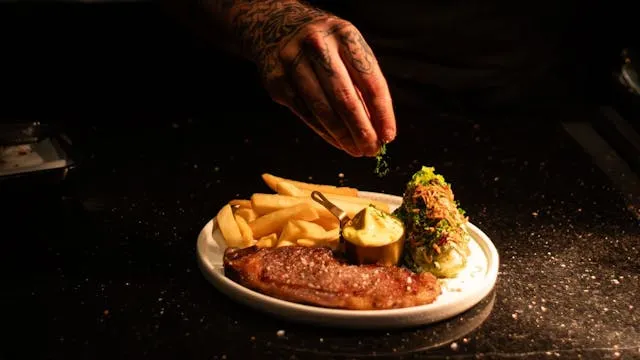There’s something deeply satisfying about cutting into a perfectly cooked steak. Whether you’re at a high-end steakhouse or grilling in your backyard, knowing how you like your steak prepared—and how to order it—can elevate the experience. Yet, many people hesitate when faced with that all-important question: “How would you like your steak cooked?” Understanding steak doneness levels can help you answer with confidence and enjoy every bite just the way you like it.
Also Read: Roseville Truck Accident Lawyer: Maximize Your Settlement
What Are Steak Cooking Levels?
Steak cooking levels, also known as doneness levels, refer to how thoroughly a steak is cooked. These levels are typically categorised based on internal temperature, colour, texture, and juiciness. The differences between each level may seem subtle, but they significantly affect the steak’s flavour and mouthfeel. Whether you like a soft, pink centre or a firm, well-seared slice, knowing the terminology can save you from mealtime disappointment.
Blue Rare
Also known as “very rare” or “bleu,” blue rare steak is cooked for the shortest amount of time. The exterior is seared quickly on high heat, while the inside remains almost entirely raw, cool, and deep red. The internal temperature reaches only about 49°C (120°F). Blue rare is ideal for those who appreciate a bold, meaty flavour and a soft, almost melt-in-the-mouth texture. It requires high-quality, fresh beef due to the minimal cooking.
Rare
A rare steak is somewhat more cooked than a blue rare, with an internal temperature of roughly 52°C (125°F). It features a cool red centre, a lightly browned exterior, and a soft, juicy interior. This doneness level preserves the steak’s natural flavour and is a favorite among purists who value tenderness and minimal charring. Rare steak still retains much of its original texture, which may not appeal to everyone, but remains a staple for steak lovers.
Medium Rare
Medium rare is often hailed as the gold standard for steak doneness. At around 55°C (130°F), it boasts a warm red centre, a pink outer layer, and a seared crust. The texture is tender and juicy without being overly soft. Chefs and food enthusiasts frequently recommend this level because it strikes the best balance between flavour, juiciness, and texture. The fat has started to render, enhancing the steak’s richness while preserving its natural moisture.
Medium
With an internal temperature of approximately 60°C (140°F), medium steak is mostly pink in the centre and firmer to the touch. While it loses some of the tenderness of rarer levels, it still maintains good moisture and flavour. Medium is a popular choice for those who prefer a bit less red on their plate but still want to enjoy the essence of a juicy steak. It’s often seen as a safe middle ground for group dining or unfamiliar cuts.
Medium Well
The interior temperature of a medium-well steak is approximately 65°C (150°F), with only a faint pink tint left in the centre. The texture is firmer, and the steak is noticeably drier compared to less-cooked options. Some flavour is sacrificed at this level, but it appeals to those who want their meat thoroughly cooked without being fully dried out. While not as juicy, a well-marbled cut can still provide a satisfying bite.
Well Done
A well-done steak is completely cooked through and free of pink at 71°C (160°F) or above. The texture is firm, sometimes tough, and the juices are mostly gone. While this level is often frowned upon by steak enthusiasts, it remains a valid choice for those who prefer the texture or are concerned about undercooked meat. With proper preparation—like slow cooking or choosing a fattier cut—a well-done steak can still be flavourful.
Making The Right Choice
Choosing the right doneness level often comes down to personal preference. Some people love the rich, juicy burst of a medium-rare steak, while others feel more comfortable with a well-done piece of meat. There’s no right or wrong choice, but understanding what each level offers helps eliminate the guesswork. If you’re new to steak, starting with medium or medium rare is a good way to explore the full flavour profile without going too raw or too firm.
Communicating Your Order
When ordering at a restaurant, don’t hesitate to clarify how you want your steak cooked. If you’re unsure about what a certain level means, ask the server or refer to any in-house guides they may offer. Some establishments even allow you to specify exact temperatures or use descriptive phrases like “warm pink centre” instead of just saying “medium.”
Keep in mind that different cuts of meat react differently to heat. For example, a thick ribeye may take longer to reach the same level of doneness than a thinner sirloin. Experienced chefs know how to adjust cooking times accordingly, but it’s worth noting when evaluating the final result.
Final Thoughts
Ordering steak shouldn’t be a gamble. With a clear understanding of steak cooking levels, you can order with confidence and savour a meal that suits your tastes perfectly. Whether you lean toward rare or well-done, the key is to know what you’re getting and enjoy it fully. After all, a great steak isn’t just about the cut—it’s about the experience.



